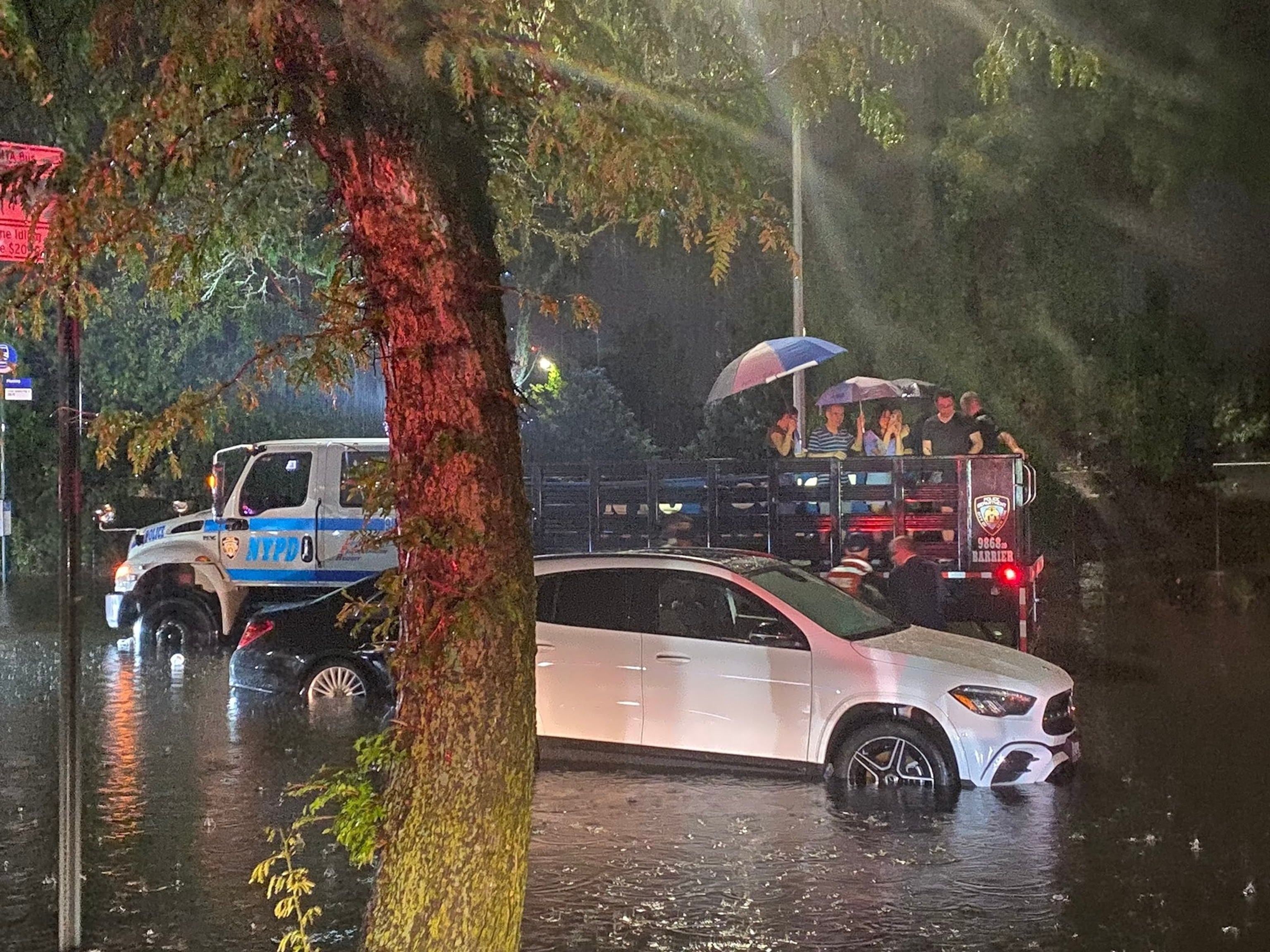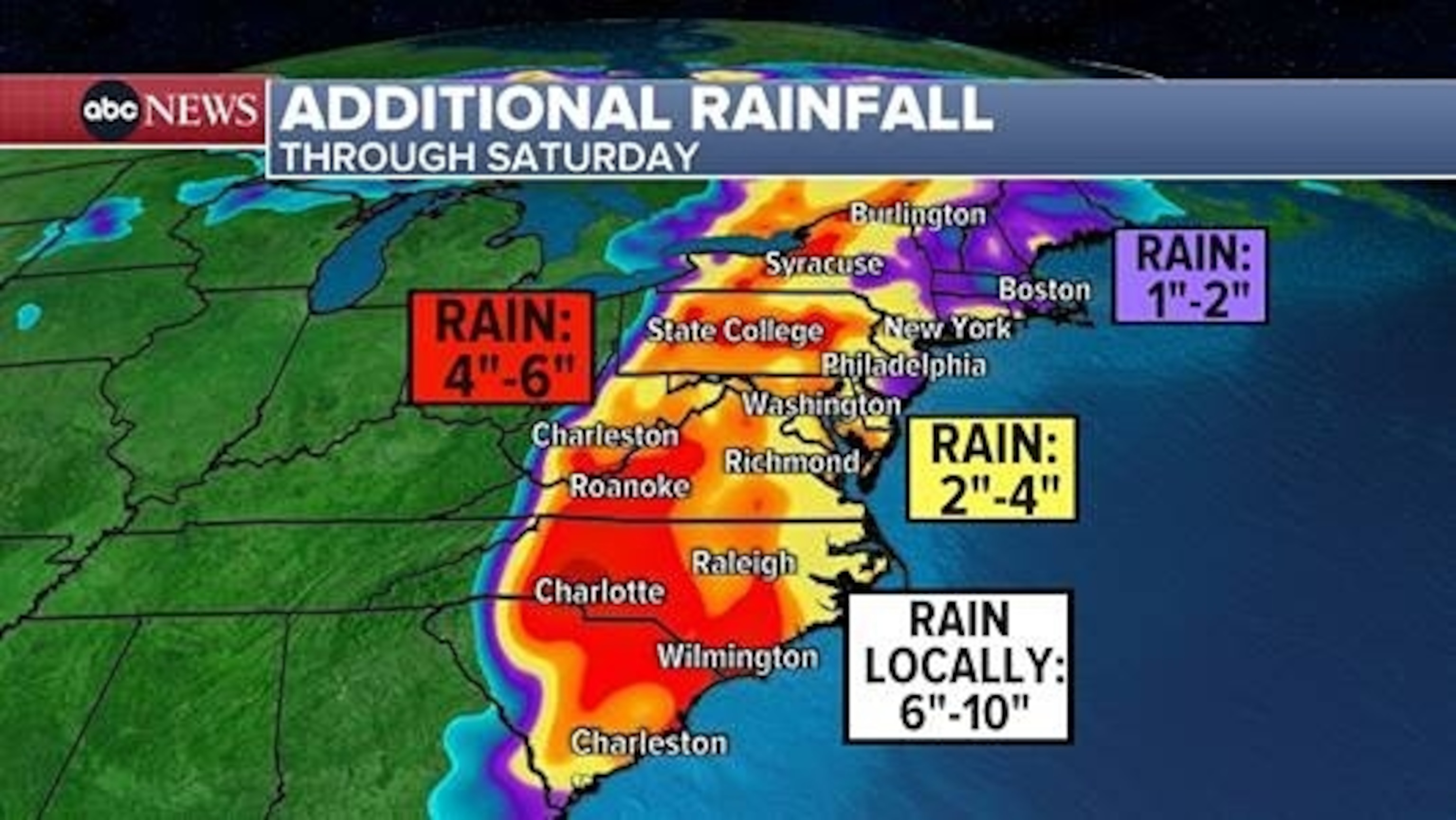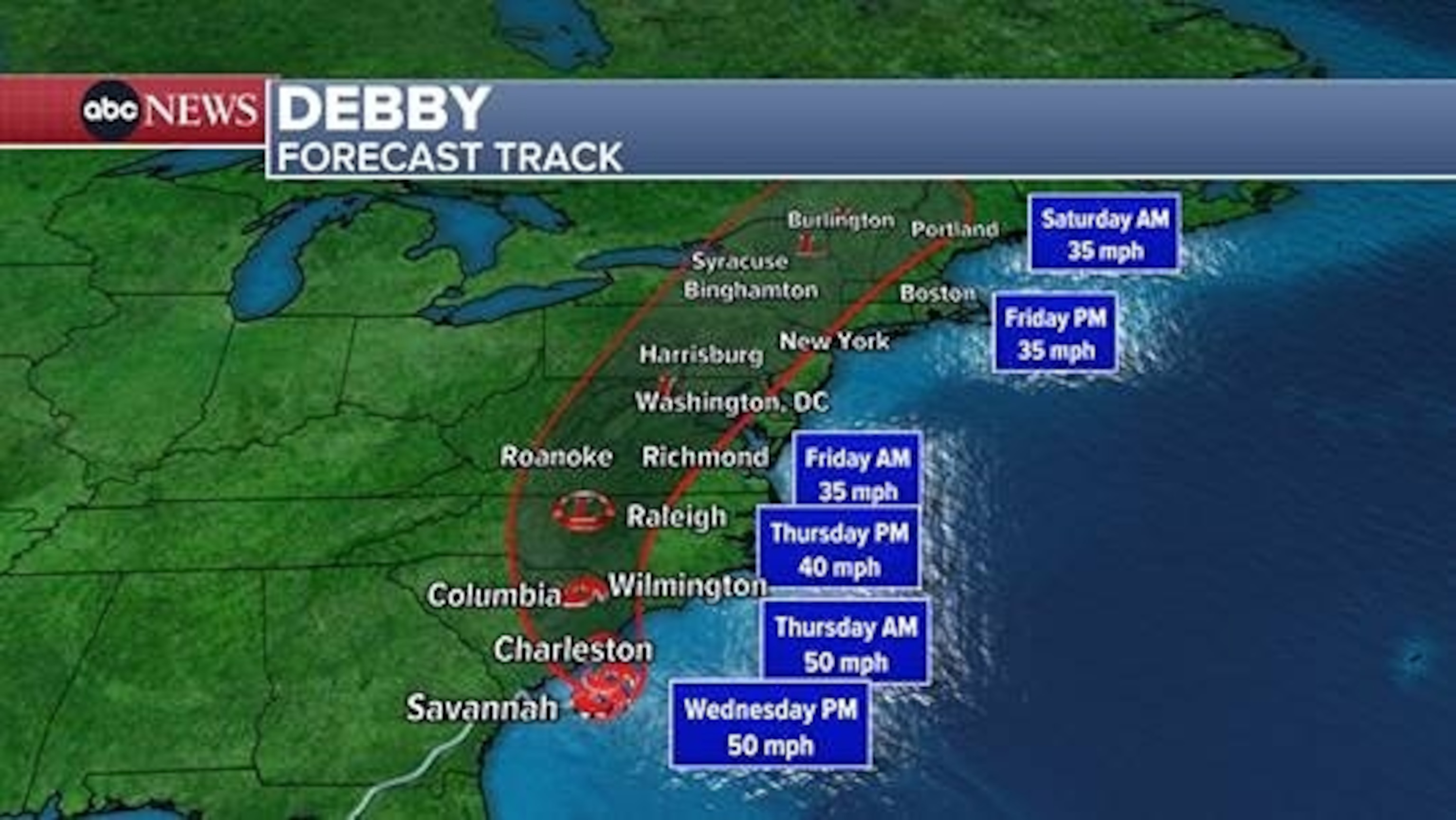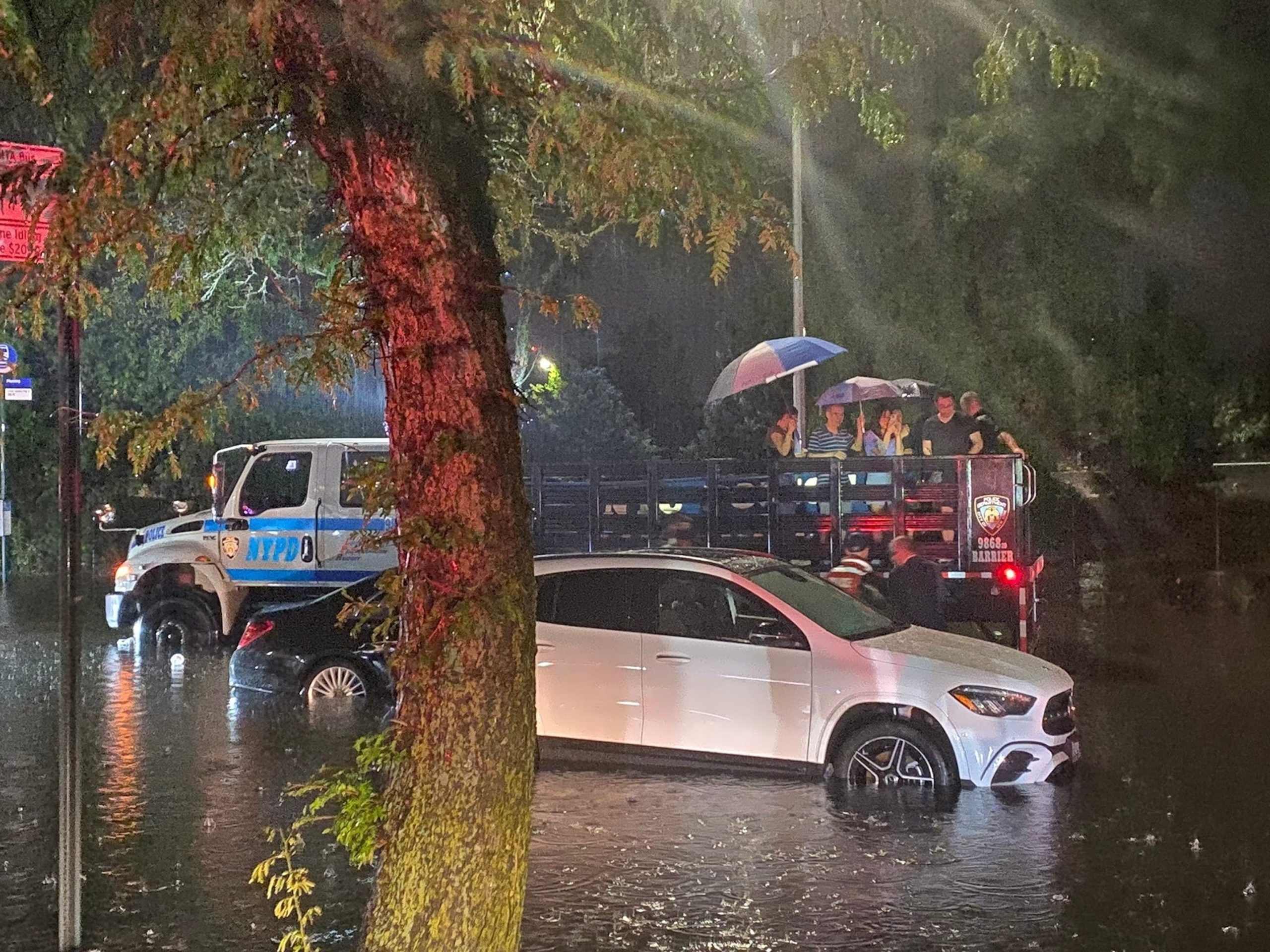Multiple motorists stranded on flooded roadways in New York and New Jersey had to be rescued from their submerged vehicles Tuesday night as some parts of the region got six inches of rain in about three hours, according to officials.
The super-soaker storm brought torrential rain to New York City, Long Island, New Jersey and Connecticut, dumping two to three inches an hour, meteorologist Bill Goodman of the National Weather Service office in Upton, New York, told ABC News on Wednesday morning.
“Between 4 p.m. and 7 p.m. is when it was really the worst. That’s rush hour,” Goodman said of Tuesday night’s storm.
He said some parts of New York City, including northern Manhattan and the Bronx, recorded up to 6 inches of rain Tuesday evening.

Six people were stranded in their cars by flash flooding on the Cross Island Parkway in New York City on Aug. 6, 2024, according to New York City Emergency Management officials.
New York City Emergency Management
New York City Emergency Management officials said multiple motorists were stranded on flooded roadways and had to be pulled from their vehicles by rescue crews.
Six people were rescued from their vehicles when they got stuck in flood waters on the Cross Island Parkway in New York City, emergency management officials said.
Flood water also inundated the Henry Hudson Parkway in the Bronx borough of New York City, where firefighters had to rescue a stranded driver, according to the New York City Fire Department. At the height of the storm, the highway was briefly closed at West 232nd Street in the Bronx, officials said.
On Long Island, police in the Nassau County town of Glen Cove had to rescue two people from a BMW that got stuck in water that authorities said was too high to drive through safely. Port Washington, about 10 miles from Glen Cove, recorded 4.66 inches of rain Tuesday evening, the most of any Long Island city, according to the NWS.
Elsewhere in the region, flooding on the Palisades Parkway in the Bergen County, New Jersey, city of Englewood Cliffs, caused commuter chaos, officials said. The Teterboro Airport in Bergen County recorded nearly four inches of rain Tuesday night, according to the NWS.
One of the hardest areas of New Jersey was Hackensack, which received nearly 3 inches of rain, according to the NWS.
In a Facebook post Tuesday night, the Hackensack Fire Department said multiple trees in the city were down and numerous streets were flooded. In a warning to motorists, the fire department said, “It continues to monsoon, please do not drive into flooded areas.”
“Multiple people stuck, multiple rescues being made by Hackensack fire members,” the Hackensack Fire Department said in the post. “If you’re in an area and cannot go any further, park your car somewhere dry and wait out the storm…. Turn around, don’t drown.”

Hurricane Debby – Additional rainfall forecast through Saturday
ABC News
There were no reports of injuries in the New York City metropolitan area.
The storm system soaked the Northeast after moving in from the eastern Great Lakes, prompting 163 damaging storm reports, including numerous downed trees and flash flooding, from Michigan to New York.
Goodman said the remnants of Hurricane Debby are forecast to reach the Northeast on Friday, bringing more rain to the region. Debby made landfall as a Category 1 hurricane Monday morning in the Big Bend area of the Florida Panhandle and produced heavy amounts of rainfall as it continued as a tropical storm into Georgia and the Carolinas.

Hurricane Debby – Forecast through Saturday
ABC News
The slow-moving Debby dumped more than 17 inches of rain in Summerville, South Carolina, and at least 6 inches in Cary, North Carolina. Another 6 to 10 inches of rain is forecast for South Carolina and North Carolina on Wednesday and Thursday.
On Thursday, Debby is expected to make its second landfall in South Carolina and then move north into inland North Carolina and Virginia Thursday night.
Rescue operations were in full swing in New Jersey and New York as multiple motorists found themselves stranded on flooded roads due to heavy rainfall and flash flooding. The swift and intense storms that swept through the region left many drivers trapped in their vehicles, unable to navigate through the rising waters.
In New Jersey, emergency responders were called to multiple locations where motorists were stuck in their cars as floodwaters rose rapidly. The Passaic River overflowed its banks, causing major roadways to become impassable. Firefighters and rescue teams worked tirelessly to reach those in need, using boats and other specialized equipment to safely evacuate stranded individuals.
In New York, a similar situation unfolded as heavy rain pounded the city and surrounding areas. The Bronx River Parkway was particularly hard hit, with several motorists becoming trapped in their vehicles as water levels rose. Rescue crews from the fire department and other agencies were dispatched to the scene, working quickly to rescue those in danger.
Thanks to the swift response of emergency personnel, all motorists were safely rescued from their vehicles and brought to dry land. No injuries were reported, but the incidents serve as a stark reminder of the dangers of driving through flooded areas during severe weather events.
Officials are urging drivers to exercise caution and avoid driving through flooded roads, as even a few inches of water can cause a vehicle to stall or be swept away. It is important to turn around and find an alternate route if encountering flooded roadways, and to never underestimate the power of fast-moving water.
As climate change continues to bring more frequent and intense storms, it is crucial for communities to be prepared for extreme weather events and for emergency responders to be equipped to handle rescue operations in challenging conditions. The recent incidents in New Jersey and New York highlight the importance of being vigilant and taking precautions to stay safe during severe weather events.



